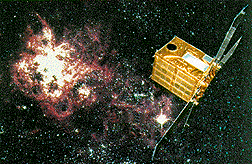Ginga (satellite)
 | |
| Names | Astro-C before launch |
|---|---|
| Mission type | X-ray Astronomy |
| Operator | Institute of Space and Astronautical Science University of Tokyo |
| COSPAR ID | 1987-012A |
| SATCAT no. | 17480 |
| Spacecraft properties | |
| Launch mass | 400 kg (880 lb) |
| Start of mission | |
| Launch date | 06:28:00, February 5, 1987 (UTC) (1987-02-05T06:28:00Z) |
| Rocket | M-3S2, mission M-3S2-3 |
| Launch site | Uchinoura Space Center |
| End of mission | |
| Decay date | November 1, 1991 (1991-11-01) |
| Orbital parameters | |
| Reference system | Geocentric |
| Eccentricity | 0.01365 |
| Perigee altitude | 517 km (321 mi) |
| Apogee altitude | 708 km (440 mi) |
| Inclination | 31.1° |
| Period | 97 min |
| Epoch | February 5, 1987 |
ASTRO-C, renamed Ginga (Japanese for 'galaxy'), was an X-ray astronomy satellite launched from the Kagoshima Space Center on 5 February 1987 using M-3SII launch vehicle. The primary instrument for observations was the Large Area Counter (LAC). Ginga was the third Japanese X-ray astronomy mission, following Hakucho and Tenma (also Hinotori satellite - which preceded Ginga - had X-ray sensors, but it can be seen as a heliophysics rather than X-ray astronomy mission). Ginga reentered the Earth's atmosphere on 1 November 1991.
Instruments
- Large Area Proportional Counter (LAC 1.5-37 keV)
- All-Sky Monitor (ASM 1-20 keV)
- Gamma-ray Burst Detector (GBD 1.5-500 keV)
Highlights
- Discovery of transient Black Hole Candidates and study of their spectral evolution.
- Discovery of weak transients in the galactic ridge.
- Detection of cyclotron features in 3 X-ray pulsars: 4U1538-522, V0332+53, and Cep X-4.
- Evidence for emission and absorption Fe feature in Seyfert probing reprocessing by cold matter.
- Discovery of intense 6-7 keV iron line emission from the Galactic Center region.
External links
- NASA/GSFC information of Ginga (ex Astro-C)
- v
- t
- e
| Radio and Microwave |
|
|---|---|
| Infrared |
|
| Optical |
|
| Ultraviolet | |
| X-ray and Gamma-ray |
|
| Other (particle or unclassified) |
- Arcus
- Astro-1 Telescope
- AstroSat-2
- EXCEDE
- Fresnel Imager
- FOCAL
- HabEx
- HWO
- Hypertelescope
- ILO-1
- iWF-MAXI
- JEM-EUSO
- LUCI
- LUVOIR
- Lynx
- Nano-JASMINE
- Nautilus Deep Space Observatory
- New Worlds Mission
- NRO donation to NASA
- ORBIS
- OST
- PETREL
- PhoENiX
- Solar-D
- Space Solar Telescope
- THEIA
- THESEUS
- AGILE (2007–2024)
- Akari (Astro-F) (2006–2011)
- ALEXIS (1993–2005)
- Alouette 1 (1962–1972)
- Ariel 1 (1962, 1964)
- Ariel 2 (1964)
- Ariel 3 (1967–1969)
- Ariel 4 (1971–1972)
- Ariel 5 (1974–1980)
- Ariel 6 (1979–1982)
- ASTERIA (2017–2019)
- ATM (1973–1974)
- ASCA (Astro-D) (1993–2000)
- Astro-1 (1990)
- Astro-2 (HUT) (1995)
- Astron (1983–1991)
- ANS (1974–1976)
- BeppoSAX (1996–2003)
- CHIPSat (2003–2008)
- Compton (CGRO) (1991–2000)
- CoRoT (2006–2013)
- Cos-B (1975–1982)
- COBE (1989–1993)
- CXBN-2 (2017–2019)
- DXS (1993)
- EPOCh (2008)
- EPOXI (2010)
- Explorer 11 (1961)
- EXOSAT (1983–1986)
- EUVE (1992–2001)
- FUSE (1999–2007)
- Kvant-1 (1987–2001)
- GALEX (2003–2013)
- Gamma (1990–1992)
- Ginga (Astro-C) (1987–1991)
- Granat (1989–1998)
- Hakucho (CORSA-b) (1979–1985)
- HALCA (MUSES-B) (1997–2005)
- HEAO-1 (1977–1979)
- Herschel (2009–2013)
- Hinotori (Astro-A) (1981–1991)
- Hisaki (SPRINT-A) (2013–2023)
- HEAO-2 (Einstein Obs.) (1978–1982)
- HEAO-3 (1979–1981)
- HETE-2 (2000–2008)
- Hipparcos (1989–1993)
- ILO-X (2024)
- IRAS (1983)
- IRTS (1995–1996)
- ISO (1996–1998)
- IUE (1978–1996)
- IXAE (1996–2004)
- Kepler (2009–2018)
- Kristall (1990–2001)
- LEGRI (1997–2002)
- LISA Pathfinder (2015–2017)
- MinXSS (2015–2017)
- MOST (2003–2019)
- MSX (1996–1997)
- Mikhailo Lomonosov (2016–2019?)
- OAO-2 (1968–1973)
- OAO-3 (Copernicus) (1972–1981)
- Orbiting Solar Observatory
- Orion 1 (1971)
- Orion 2 (1973)
- PAMELA (2006–2016)
- PicSat (2018)
- Planck (2009–2013)
- RELIKT-1 (1983–1984)
- R/HESSI (2002–2018)
- ROSAT (1990–1999)
- RXTE (1995–2012)
- SAMPEX (1992–2004)
- SAS-B (1972–1973)
- SAS-C (1975–1979)
- Solwind (1979–1985)
- Spektr-R (2011–2019)
- Spitzer (2003–2020)
- Suzaku (Astro-EII) (2005–2015)
- Taiyo (SRATS) (1975–1980)
- Tenma (Astro-B) (1983–1985)
- Uhuru (1970–1973)
- Vanguard 3 (1959)
- WMAP (2001–2010)
- Yokoh (Solar-A) (1991–2001)
(Mission completed)
 Category:Space telescopes
Category:Space telescopes
 | This article about one or more spacecraft of Japan is a stub. You can help Wikipedia by expanding it. |
- v
- t
- e
 | This article about a specific observatory, telescope or astronomical instrument is a stub. You can help Wikipedia by expanding it. |
- v
- t
- e


















